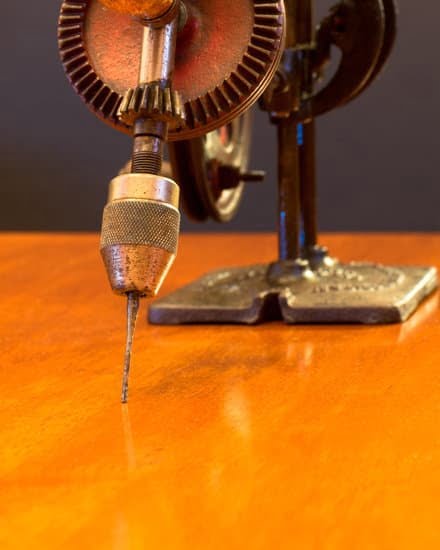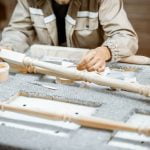Are you an avid woodworker looking to enhance your craft and work more efficiently? In this article, we will explore the practicality and usefulness of a woodworker’s leg vise. If you’re wondering how to make a woodworker’s leg vise, look no further. This essential woodworking tool can greatly improve the quality and ease of your woodworking projects.
A woodworker’s leg vise is a versatile and valuable addition to any workshop. It provides a sturdy grip on workpieces, allowing for precision and control during various woodworking tasks. Whether you are a seasoned professional or just starting out in woodworking, understanding the components and construction process of a leg vise will be invaluable.
In the following sections, we will delve into the essential components needed for building a leg vise, tips for selecting the right materials, step-by-step construction instructions, as well as guidance on installation and fine-tuning. Additionally, we’ll explore practical applications where a woodworker’s leg vise can significantly improve the outcome of woodworking projects.
So let’s get started on this journey to discover how to make a woodworker’s leg vise and unlock its full potential in your workshop.
Understanding the Components
Building a woodworker’s leg vise requires careful consideration of the essential components needed to ensure its functionality and durability. Here are the key parts that you will need to construct a woodworker’s leg vise:
Components Needed:
- Wooden Vise Chop: The wooden vise chop is the main component of the leg vise and provides the clamping surface for securing workpieces. It is typically made from hardwood such as maple or oak for durability.
- Guide Rail: The guide rail is a long piece of wood that acts as a track for the vise screw, allowing it to move smoothly up and down when clamping workpieces.
- Vise Screw: The vise screw is responsible for applying pressure to the workpiece. It consists of a long threaded rod and a handle for turning the screw.
- Vise Nut: The vise nut is an essential component that works in conjunction with the vise screw to tighten or release the clamping action.
- Reinforcing Metal Hardware: Metal reinforcing hardware such as steel rods, washers, and nuts are used to provide additional strength and support to the wooden components of the leg vise.
Understanding these essential components will enable you to gather the necessary materials before embarking on constructing a woodworker’s leg vise. Once all the required parts are acquired, you can proceed with selecting the right materials such as high-quality hardwood and sturdy metal hardware for building a durable and functional leg vise.
By understanding these crucial components, you will be well-equipped to begin gathering materials and embarking on constructing your own woodworkers leg vise. Understanding how each part contributes to the overall functionality of the vise will ensure that you select high-quality materials that will result in a reliable tool for your woodworking projects.
Selecting the Right Materials
When it comes to constructing a durable and reliable woodworkers leg vise, selecting the right materials is crucial. The quality of the wood and metal used will directly impact the functionality and longevity of the vise. Here are some essential tips for choosing the best materials for building a sturdy and reliable leg vise.
Quality Wood Selection
The type of wood you choose for constructing the jaws and handle of your leg vise plays a significant role in its performance. Hardwoods such as maple, oak, or beech are popular choices due to their strength, durability, and resistance to wear and tear. It’s important to select dense, straight-grained wood that can withstand the clamping force without easily deforming or splitting.
Durable Metal Components
In addition to selecting high-quality wood, choosing the right metal components for the hardware of the leg vise is equally important. Look for sturdy steel or iron hardware that can handle heavy-duty clamping tasks without bending or breaking. The screw mechanism, guide rails, and other metal parts should be robust and well-constructed to ensure smooth operation and long-term reliability.
Balancing Cost and Quality
While it’s important to prioritize quality when selecting materials for your woodworkers leg vise, it’s also essential to balance cost considerations. High-quality hardwoods and metal components can be more expensive, but they will ultimately provide better performance and longevity. Consider investing in superior materials that will ensure the durability and functionality of your leg vise in the long run.
By following these tips for selecting the right materials, you can ensure that your woodworkers leg vise is built to last and perform reliably for years to come.
Step-by-Step Construction Process
Building a woodworkers leg vise can be a valuable addition to any woodworking workspace, providing stability and functionality for various tasks. Here are the detailed instructions on how to make a woodworkers leg vise:
1. Cutting the Wood: Start by cutting the wooden components of the leg vise to the desired lengths. The main parts include the vise jaw, the guide rail, and the handle. Use high-quality hardwood such as maple or oak for durability and strength.
2. Shaping the Components: Once the wood is cut to size, use appropriate tools like a chisel and rasp to shape the vise jaw and handle. Round off any sharp edges and ensure that all components fit together smoothly.
3. Assembling the Vise: Now it’s time to assemble the components of the leg vise. Attach the guide rail to your workbench using sturdy bolts or screws, ensuring it is securely mounted in place. Then, attach the vise jaw to the guide rail with a solid pivot joint that allows smooth movement.
4. Adding Metal Hardware: To ensure durability and smooth operation, add metal hardware such as a threaded rod and handle bracket to your leg vise assembly. This will provide strength and stability when clamping workpieces.
5. Finishing Touches: Sand down any rough surfaces and apply a protective finish such as varnish or linseed oil to protect the wood from wear and tear over time.
By following these step-by-step instructions, you can create a woodworkers leg vise that is robust, functional, and built to last for years of woodworking projects.
Installing the Vise
When it comes to installing a woodworkers leg vise, proper mounting is essential for ensuring maximum stability and functionality. The vise should be securely attached to the workbench to withstand the force and pressure applied during woodworking tasks. Here’s how to properly install a leg vise onto your workbench.
Preparation and Planning
Before you begin the installation process, it’s important to carefully plan where you want to position the leg vise on your workbench. Consider factors such as ease of access, available space, and the type of woodworking tasks you’ll be performing. Once you have determined the ideal location for the vise, mark out the areas where you will need to make holes for mounting.
Mounting Process
To mount the leg vise securely onto your workbench, start by attaching the wooden jaw to the underside of the bench using heavy-duty screws or bolts. It’s crucial to ensure that this part is firmly attached, as it will bear most of the pressure when clamping workpieces. Next, position the metal screw mechanism in place and use a drill to create holes for fastening. Once everything is positioned correctly, secure the screw mechanism in place using sturdy hardware.
Final Adjustments
After mounting the woodworkers leg vise onto your workbench, take some time to test its functionality and make any necessary adjustments. Ensure that the vise operates smoothly and that there are no wobbles or instability when clamping workpieces. Make any fine-tuning adjustments as needed to guarantee that the vise functions optimally. Following these steps will result in a securely mounted leg vise that provides maximum stability and functionality for all your woodworking needs.
By following these guidelines, you can successfully install a woodworkers leg vise onto your workbench, allowing you to tackle various woodworking projects with ease and precision.
Adjusting and Fine-Tuning
After constructing your woodworker’s leg vise, it is essential to properly adjust and fine-tune it to ensure that it operates smoothly and securely grips workpieces. Here are some tips on how to achieve the best results:
1. Lubrication: Make sure to lubricate all moving parts of the leg vise, including the screw and guide bars. This will ensure that the vise operates smoothly without any sticking or resistance. Using a high-quality lubricant will also prevent wear and tear on the components over time.
2. Adjusting the Tension: One of the most important adjustments you can make is setting the tension of your leg vise. This will determine how firmly it grips your workpieces. You’ll want to find a balance between a secure grip and smooth operation. Test out different tension settings to see what works best for your specific woodworking projects.
3. Checking Alignment: It’s crucial to check that all components of the leg vise are properly aligned. This includes ensuring that the guide bars are parallel and that the jaw moves in a straight line when operated. Any misalignment can cause issues with grip and overall functionality.
| Tips for Adjusting | Description |
|---|---|
| Lubrication | Ensure all moving parts are properly lubricated for smooth operation |
| Adjusting Tension | Finding the right level of tension for a secure grip without sacrificing smooth operation |
| Checking Alignment | Verify that all components are properly aligned for optimal functionality |
Practical Applications
A woodworkers leg vise is a versatile and essential tool in woodworking, offering stability, precision, and control when working on various projects. Whether you’re a beginner or an experienced woodworker, understanding the practical applications of a leg vise can enhance your woodworking experience and make tasks more manageable. From holding pieces firmly in place to providing support for intricate cutting and shaping, a well-constructed leg vise can be a valuable asset in the workshop.
One of the primary uses of a woodworkers leg vise is to hold workpieces firmly in place while working on them. Whether you’re sawing, planing, chiseling, or carving, the grip provided by the vise ensures that your workpiece remains stable and secure throughout the process. This stability not only improves accuracy and precision but also reduces the risk of injury by preventing slipping or movement of the workpiece.
Additionally, a leg vise can be especially useful when working with larger or heavier pieces of wood. For tasks such as joining boards, flattening surfaces, or creating complex joinery, having a reliable support system like a leg vise can significantly ease the workload and allow for more controlled movements. The vise’s ability to firmly grasp onto the piece allows for intricate detailing and shaping without the concern of instability or shifting during work.
Furthermore, a woodworkers leg vise is also beneficial when performing repetitive tasks that require consistency and uniformity. By securing pieces in place with the vise, woodworkers can ensure that each cut, drill hole, or mortise is executed with precision and maintains consistent measurements throughout the project.
This level of control not only saves time but also enhances the overall quality of the finished piece. Therefore it’s clear how these vises play an essential role in ensuring productive efficient tasks are achieved as there are many options to explore based on what type fo project you may aim to complete.
Maintenance and Care
In conclusion, building a woodworker’s leg vise can be a highly rewarding project for those passionate about woodworking. By understanding the practicality and usefulness of a leg vise in woodworking, selecting the right materials, and following the step-by-step construction process, anyone with the proper tools and dedication can create their own durable and functional leg vise.
Additionally, installing the vise securely onto a workbench and adjusting it for smooth operation are crucial steps in maximizing its stability and functionality.
Once your woodworker’s leg vise is installed and operational, it is important to prioritize maintenance and care to ensure its longevity and top condition. Regular lubrication of moving parts will help prevent wear and tear, while conducting routine inspections will allow you to catch any issues early on before they become major problems. By incorporating these maintenance tips into your woodworking routine, you can enjoy the benefits of your woodworker’s leg vise for years to come.
Finally, by exploring different woodworking tasks and projects where a leg vise can be a valuable tool, woodworkers can fully appreciate the utility of their creation. Whether it’s holding workpieces in place for accurate cutting or providing a secure grip for intricate carving, a well-maintained woodworker’s leg vise can significantly enhance both the precision and safety of various woodworking endeavors.
As such, investing time in building, maintaining, and utilizing this essential tool is sure to be a worthwhile endeavor for any woodworking enthusiast.
Frequently Asked Questions
How Thick Should a Leg Vise Be?
The thickness of a leg vise depends on the type and size of the woodworking projects it will be used for. In general, a thicker leg vise provides more stability and strength, but a thickness of around 1.5 to 2 inches is common for most woodworking applications.
What Is the Best Wood for a Woodworking Vise?
The best wood for a woodworking vise is one that is strong, dense, and resistant to wear. Hardwoods like maple, oak, or beech are popular choices due to their durability and ability to withstand the pressure and friction of clamping workpieces. Additionally, these woods are less likely to dent or deform under pressure compared to softer varieties.
How Do You Make a Wooden Vice?
Making a wooden vise involves several steps, including selecting the appropriate wood material, cutting and shaping the vise components, drilling holes for hardware installation, and assembling all the parts together.
The process typically requires precise woodworking skills and tools such as saws, chisels, drills, and clamps to ensure that the wooden vice functions properly and securely holds workpieces in place during use.

Hi everyone! I’m a woodworker and blogger, and this is my woodworking blog. In my blog, I share tips and tricks for woodworkers of all skill levels, as well as project ideas that you can try yourself.





